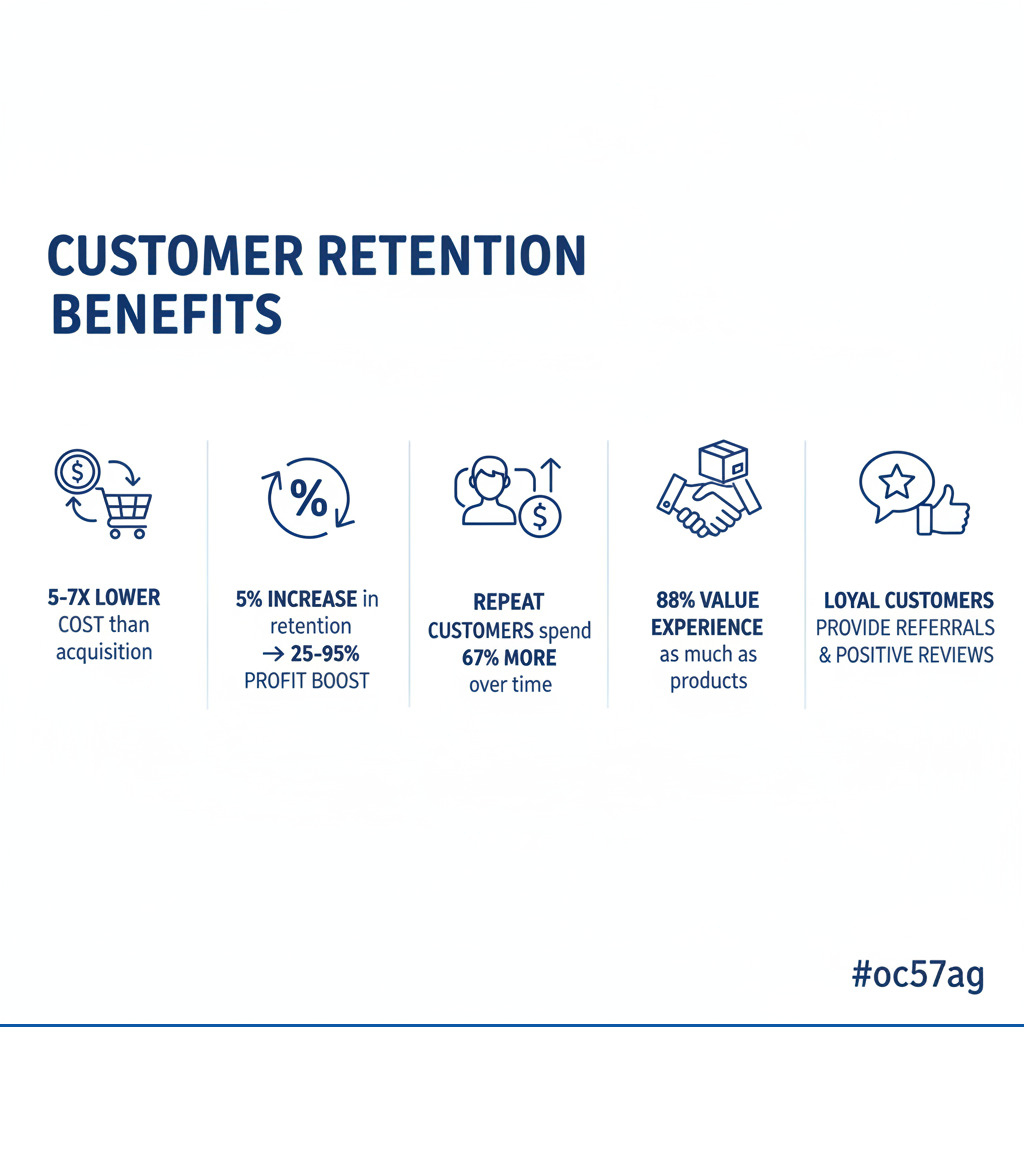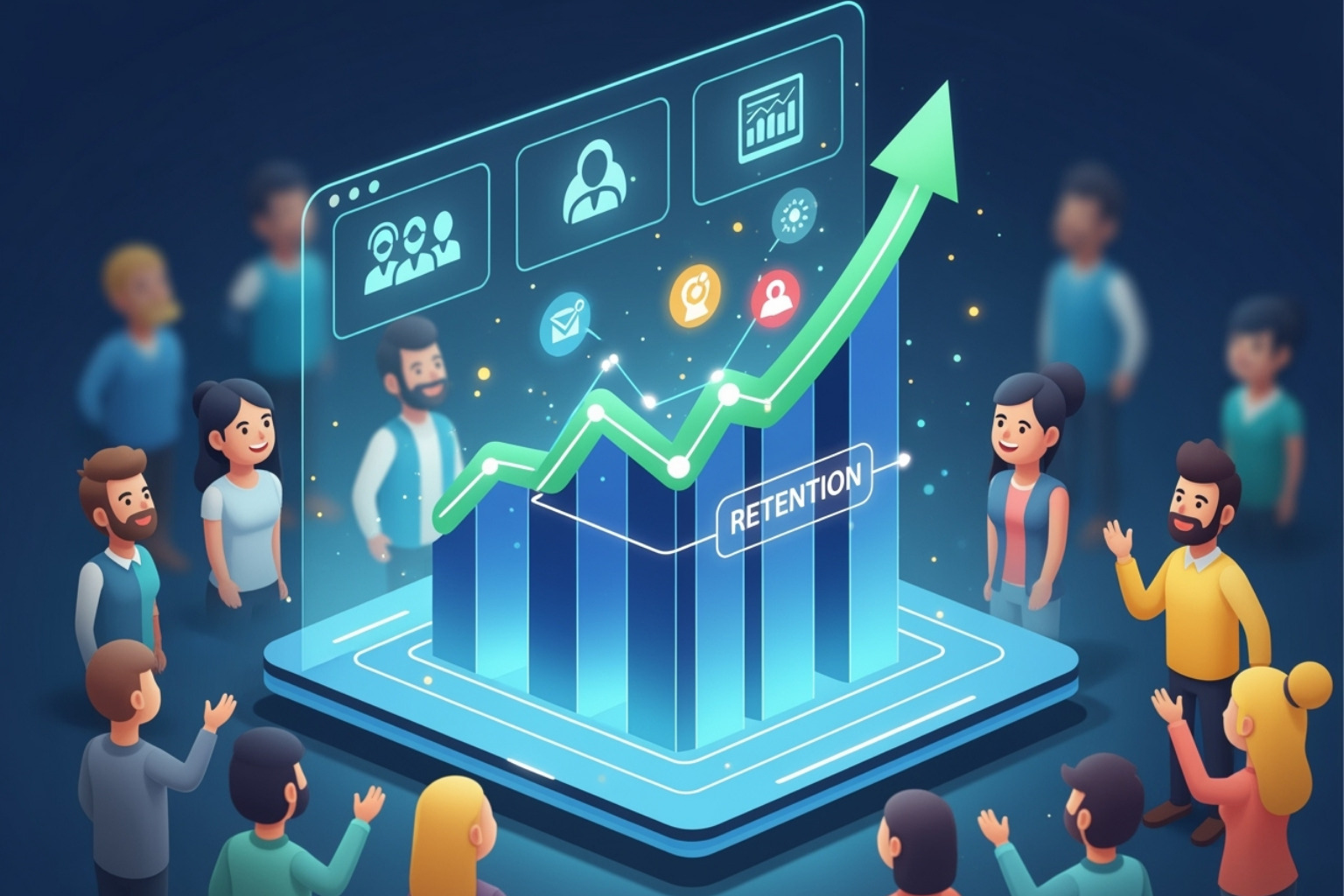Why Your Existing Customers Are Your Greatest Asset
To improve customer retention rate, focus on these key plans:
- Create exceptional customer experiences from the first interaction through post-purchase support
- Build relationships through smart communication using personalized emails and regular interaction
- Provide outstanding service and support with easy returns and quick complaint resolution
- Use rewards and incentives like loyalty programs, referrals, and subscriptions
- Measure what matters by tracking retention rate, CLV, and churn metrics
Acquiring a new customer costs five to seven times more than keeping an existing one. Yet many e-commerce businesses pour resources into acquisition while overlooking their greatest asset—the customers they already have.
Research shows that increasing customer retention rates by just 5% can boost profits by 25% to 95%. In the apparel sector, repeat customers spend 67% more in months 31-36 of their relationship compared to their first six months. Plus, 88% of customers say the experience a company provides is as important as its products or services.
You've already done the hard work of earning that first purchase. Your customers know your brand, trust your products, and have their payment information saved. They're ready to buy again—if you give them a reason.
Customer retention goes beyond repeat purchases. Loyal customers become brand supporters who leave positive reviews, refer friends, and provide valuable feedback. They're more forgiving when things go wrong and more willing to try new products.
Building loyalty requires more than a good product. It demands a focus on the entire customer experience, from your website's usability to your support response time. It means using data to understand customer needs and requires consistent effort across every touchpoint.
As Steve Pogson, founder of First Pier, I've spent over two decades helping e-commerce businesses improve customer retention rate through Shopify optimization and data-driven marketing. The businesses that thrive aren't just chasing new customers—they're turning first-time buyers into lifelong fans.

Measuring What Matters: Key Retention Metrics for Your Business
You can't fix what you don't track. Many e-commerce businesses focus on making sales without understanding what happens after the purchase.
If you want to improve customer retention rate, you need to get comfortable with a few key numbers. The good news is that Shopify analytics provides most of this data right out of the box.
Think of these metrics as your business's vital signs. Regularly checking them helps you understand the health of your customer base and act on issues before they grow.
A great tool for this is Customer Cohort Analysis Shopify. It lets you track how different groups of customers behave over time, revealing patterns you wouldn't otherwise see.
How to Calculate Customer Retention Rate
Let's start with your customer retention rate (CRR). This metric shows the percentage of customers who stick around over a specific period.
The formula is:
CRR = [(E - N) / S] × 100
Here’s what the letters mean: E is the number of customers at the end of the period, N is the number of new customers acquired during that period, and S is the number of customers you started with.
For example, say you start January with 100 customers. During the month, you gain 20 new customers and end with 105 total customers.
Plug those numbers in: [(105 - 20) / 100] × 100 = 85%
This means you kept 85% of your original customers. A 100% rate means you lost no one, while 0% means you lost everyone.
Before comparing your numbers, know that "good" retention rates vary by industry. Per Shopify, some industry-specific retention rates are: media at 84%, professional services at 84%, automotive at 83%, finance at 78%, and software at 77%.
E-commerce typically sees around 30%.
While that sounds low, it reflects the reality of online shopping, where customers have endless options. This is why working to improve customer retention rate is so important—every percentage point gained adds to your revenue.
Other Essential Retention Metrics to Watch
Your retention rate is important, but it's not the whole picture. I always look at these additional metrics to understand customer loyalty:

Customer Churn Rate is the flip side of your retention rate. If you retain 85% of customers, your churn rate is 15%. A rising churn rate is a warning sign that something needs attention.
Customer Lifetime Value (CLV) predicts the total revenue you'll earn from a single customer. This metric is gold because it shows how much you can afford to spend on acquiring new customers. When CLV goes up, customers are staying longer and spending more. Our guide on how to Increase Customer Lifetime Value breaks down tactics for boosting this number.
Repeat Purchase Rate shows the percentage of customers who buy again. A low rate means you're attracting customers but not turning them into fans.
Average Order Value (AOV) measures how much customers spend per transaction. While not strictly a retention metric, I track it alongside the others. When repeat customers spend more per order, it signals growing trust in your brand.
The real magic happens when you look at these metrics together. For example, a solid retention rate but low CLV means customers are staying but not spending much. Each combination tells a different story and points you toward specific solutions.
Proven Plans to Improve Customer Retention Rate
After two decades in e-commerce, I've learned that improving customer retention rate is an ongoing process. It's a relationship requiring proactive plans (anticipating needs) and reactive ones (solving problems quickly).
Trust is at the core of retention. While 61% of customers find it hard to trust a company, 88% say the experience is as important as the product itself. This means every interaction, from browsing your site to contacting support, either builds or breaks trust.
My approach at First Pier focuses on creating a customer experience that exceeds expectations. We aim to build loyal supporters for your brand. For more details, see our guide on Ecommerce Customer Retention Plans.

Create a Flawless Customer Experience from Day One
Your customer relationship starts before the first purchase. Those initial interactions set the tone for everything that follows.
A confusing or frustrating initial experience can lose customers quickly. Gartner research shows that three in five software buyers regret a purchase due to hidden costs, slow setup, or unmet expectations—all issues from poor onboarding.
A smooth onboarding process gives new customers confidence in their purchase. Provide clear instructions, helpful tutorials, or personalized assistance so they can get the most value from your product.
Setting realistic expectations is also key. It's better to underpromise and overdeliver. Be honest about your product's capabilities; customers appreciate transparency and will trust you more for it.
Your website's user experience is critical. A confusing checkout, slow loading times, or hard-to-find information can drive customers away. Brands like Pepper use a quick fit quiz for personalized recommendations, making shopping effortless.
Personalization goes beyond using a first name in an email. It means understanding customer needs and tailoring their experience. My team uses data for Personalization in E-commerce to create unique customer experiences that make people feel valued.
Nailing the first experience lays the foundation for a long-term relationship that will improve customer retention rate.
Build Lasting Relationships with Smart Communication
After a great first impression, keep the conversation going with communication that adds value.
Email marketing is a powerful retention tool, with companies attributing 23% of total sales to it. I help clients create automated, personal email sequences like welcome series or post-purchase follow-ups that offer tips and suggest related products.
Mack Weldon excels at this, using email to encourage reviews and offer personalized recommendations. For strong email plans, I suggest exploring Klaviyo Email Marketing for its automation tools.
Asking for feedback shows you care. Simple post-purchase surveys can uncover hidden issues. A quick tip: asking "What made you cancel?" instead of "Why did you cancel?" can double response rates by sounding less accusatory.
Customer reviews matter a lot. Gartner reports that one in three buyers considers them the most important factor in a purchase. Encourage happy customers to share their experiences.
Social media is also a great retention channel for building community. Respond to comments, answer questions, and share user-generated content to humanize your brand. Since 92% of people trust recommendations from people they know, social interaction helps build those connections.
Thoughtful, valuable communication keeps your brand top-of-mind and strengthens relationships, which helps improve customer retention rate.
Turn Great Service and Support into Loyalty
How you handle a customer's problem often matters more than the problem itself. I've seen upset customers become brand supporters after one great support interaction.
The stakes are high. For every customer who complains, 26 others may leave silently. This makes exceptional service essential.
Customers who feel heard and respected stick around. Speed and empathy matter. Customers spend 13% more with companies that provide good support. It's not just about solving problems quickly; it's about making people feel valued.
Complaints are opportunities. Instead of seeing them as problems, view them as chances to turn a negative experience positive. Take ownership, apologize sincerely, offer a clear solution, and explain how you'll prevent it from happening again. A well-handled complaint can turn an unhappy customer into a loyal supporter.
Returns are inevitable in e-commerce but don't have to hurt retention. Since 67% of people check the return policy before buying, a bad experience can be damaging—58% of customers won't buy again after one.
Make your return policy clear and easy. Outline what qualifies for a return to avoid surprises. Make the process simple. Chubbies, for example, offers free returns and exchanges and lets customers start the process online.
Consider using services like Loop Returns or AfterShip for an online portal where customers can manage returns without overwhelming your support team.
By prioritizing service and support, you build trust that will improve customer retention rate long-term.
How to use rewards and incentives to improve customer retention rate
Rewards and incentives give customers tangible reasons to choose your brand. They are strategic tools that drive repeat purchases and build loyalty.
Loyalty programs reward consistent interaction. Customers earn points on purchases to redeem for discounts or exclusive products. Nerdy Nuts, for example, rewards customers with each online purchase. Programs can be simple or have complex tiers. Shopify businesses can find great tools to manage Customer Loyalty Programs on Shopify.
Referral programs turn happy customers into marketers. Offer incentives to both the referrer and the new customer. This uses the power of word-of-mouth. Dia & Co saw referral links shared over 50,000 times, resulting in about 22 conversions per day in the first month.
Subscription models work well for regularly used products, creating predictable revenue and effortless repurchasing. Splash Wines used a subscription to let customers "lock in" sale prices, leading to a 177% sales increase. Jill & Ally's crystal candle club creates excitement with tiered discounts and early product access.
A direct discount or store credit can also be effective. Harney & Sons Fine Teas emails customers a $10 discount code for their next order. Store credits can feel more flexible than percentage discounts.
Gamification adds fun to shopping with points or badges, encouraging repeat visits.
Don't forget surprise and delight moments. Unexpected gestures like a free sticker (West Path) or a handwritten note create memorable experiences.
By using these rewards, you build a community of appreciated customers and improve customer retention rate for the long term.

Frequently Asked Questions about Improving Customer Retention
I get asked these questions all the time by clients serious about keeping their customers happy. Here's what I've learned from helping e-commerce businesses build loyal customer bases.
What is a good customer retention rate?
This is the most common question, and the answer is always: it depends on your industry. There's no single magic number.
For e-commerce, the average retention rate is around 30%. This might seem low compared to industries like media or professional services, which can see rates of 77-84%.
Don't get caught up in hitting an industry average. What matters is your own progress. Moving from 25% to 30% is a significant win.
The goal is to continuously improve customer retention rate for your business. Compare against your past performance first, using industry standards as a reference. Small, steady improvements compound over time and can dramatically impact your bottom line.
What are the most common reasons for customer churn?
Understanding why customers leave is half the battle. I've seen the same issues appear repeatedly.
Poor customer service is the top reason. Research shows 68% of customers leave due to poor treatment. A slow or unhelpful response—or no response at all—leaves a lasting negative impression.
Unmet expectations are a close second. When a product doesn't deliver as promised, customers feel misled. This often happens during onboarding, as Gartner research shows.
Lack of personalization drives away more customers than many owners realize. People expect experiences custom to them, not generic messages that make them feel like just another transaction.
Complicated processes create friction. A difficult checkout, confusing navigation, or a complex return process can send customers to your competitors.
Better competitor offers will always be a factor. You can't control what others do, but you can control the value and experience you provide. Make your overall experience so good that price becomes less of an issue.
By addressing these common pain points, you can reduce churn and improve customer retention rate.
What is the first step to improve customer retention?
You can't fix what you don't measure. The first step to improve customer retention rate is to understand where you stand now.
Start by calculating your current customer retention rate using the formula I shared earlier. This gives you a baseline for improvement.
Next, identify your most valuable customers. Not all customers contribute equally. Use Customer Lifetime Value (CLV) to find out who your best customers are. Understanding their behaviors helps you attract and keep more like them. I find Customer Cohort Analysis Shopify helpful for this.
Finally, listen to what your customers are telling you. Gather feedback from loyal customers to learn what keeps them coming back. More importantly, reach out to those who've left. Exit surveys and social media monitoring can show painful truths about what's not working. Insights from lost customers are often more valuable than praise from happy ones.
Once you have this foundation—your current rate, knowledge of your best customers, and honest feedback—you can develop targeted plans to address problems and build on your strengths.
To Sum Up: Making Retention Your Growth Engine
After two decades in e-commerce, I know that winning businesses aren't just hunting for new customers—they're making their existing customers feel valued.
Everything in this guide comes down to one truth: customer retention is your most powerful growth engine. When you improve customer retention rate by just 5%, you can increase profits by 25% to 95%. That's real money to fund new products, hire talent, or build something special.
When you focus on retention, loyal customers buy more often, spend more, forgive mistakes, and refer friends. They become the foundation of a sustainable business that doesn't rely on expensive ads.
The plans I've shared aren't complicated. They're about treating people well, keeping promises, and going the extra mile.
But knowing what to do and doing it are different. You need the right tools, platform, and team to carry out these plans effectively. That's where we come in.
At First Pier, we help e-commerce businesses create customer experiences that turn first-time buyers into lifelong fans. We specialize in Shopify development and optimization, providing a rock-solid foundation for growth. Our Portland, Maine team works with brands ready to stop chasing and start nurturing.
If you're tired of watching customers leave after one purchase, let's talk. Find out how to build a loyal customer base with our retention solutions and turn your existing customers into your greatest asset.
Your customers have already said yes once. Now, give them every reason to keep saying yes.







